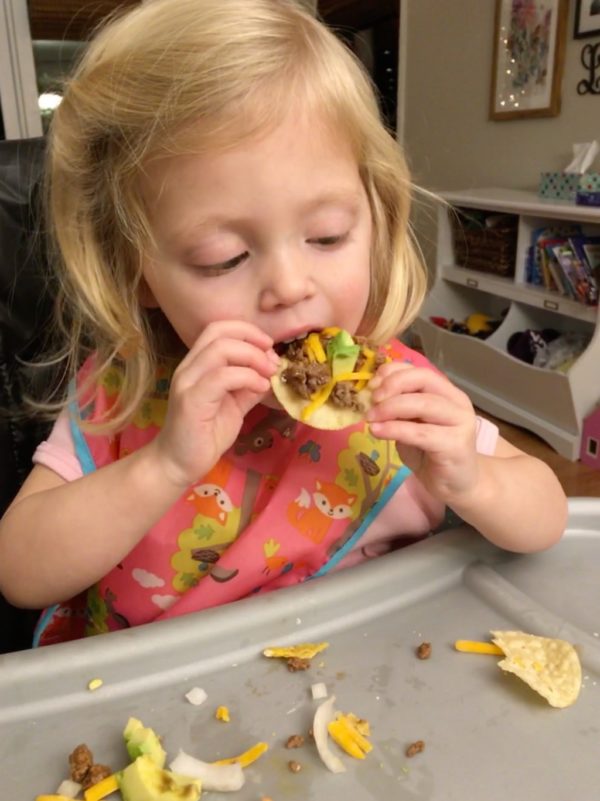 I was checking the date of my daughter’s next appointment in her online medical record account and there it was, “failure to thrive”. It was listed in black and white under her current medical problems. I knew in my head that it was just describing the fact that her weight had slipped below the 1st percentile for height for her age, but it may as well have said, “her mother is failing.” Failing at getting enough calories into her child so that she can grow and develop normally.
I was checking the date of my daughter’s next appointment in her online medical record account and there it was, “failure to thrive”. It was listed in black and white under her current medical problems. I knew in my head that it was just describing the fact that her weight had slipped below the 1st percentile for height for her age, but it may as well have said, “her mother is failing.” Failing at getting enough calories into her child so that she can grow and develop normally.
At birth she only weighed 2lb13oz so we knew we weren’t rearing the next heavy weight champion. However, how difficult could it be to get a baby to gain weight? Babies get hungry, they eat via the means they are being offered (bottle, breast, etc) and then they grow and gain weight, right? Claire quickly taught us that it can get much more complicated that that. She was too small and weak to take her calories by mouth for about the first 4 weeks of her life, so at birth she had a feeding tube inserted into her nose so that milk could be delivered directly to her tummy. Breast milk was mixed with formula for added calories to give her the best chance of gaining much needed weight quickly. She tolerated this quite well and every day was able to increase the amount of milk she got at each feed. She gained the requisite weight needed for discharge and we were sent home from the hospital with the instruction to “keep gaining weight.”
Things started to get a little interesting when we were at home on our own. She lost too many calories nursing (and often fell right to sleep while nursing) so she was bottle fed fortified breast milk. We fortified the milk diligently using the recipe the dietitian gave us in the hospital. For every 3oz of breast milk, 1 tsp of formula was added to increase the number of calories from 20 calories/oz to 22 calories/oz. I still have the godforsaken chart memorized. I can’t remember my kids’ birthdate half the time, but don’t worry, I know how to fortify breast milk.
Claire developed some new and interesting tricks at home. At least once daily, sometimes more, she would projectile vomit the entire contents of a bottle. This was incredibly devastating as typically you would have just spent 30-40 minutes coaxing her to take the bottle in the first place. We got really creative with draping blankets and towels over all the furniture and carpet in our house. We found that it was a lot easier to throw a blanket into the washing machine than to scrub milky baby vomit out of an upholstered chair at 3am. She seemed to think that it was a game. She seemed to aim for the one square of uncovered couch cushion and she could hit it with incredible accuracy. Whoever’s turn it was to feed Claire was always alert and at the ready to jump to attention and try to get her positioned over the hard wood floor for her daily spew. This was really tough in the middle of the night when our faculties were not functioning at 100%. Eventually she started medicines for reflux, but this didn’t seem to change her daily puking habit.
Claire’s other little idiosyncrasy was that she didn’t want the person feeding her to relax into a comfy arm chair and cuddle her while she fed. She wanted them to work for it. She would take the milk if she was being walked around the house at a swift pace and being gently bounced. The only people who were able to perfect this dance were me, her dad and her angel of a nanny, Megan. Most of the time, if the feeder wasn’t walking around, she simply cried and refused to put the nipple in her mouth. Thinking back, I’m not quite sure why we thought this was even close to normal feeding behavior. I blame sleep deprivation and being a first time mom to twins. (Lucky for us, her twin was one of those babies that saw the bottle, sucked it down immediately, and never lost a drop). We were zombies and simply following the instructions from the health care providers trying to get her to eat more everyday. With this method we did keep her weight hovering at the 3rd percentile on the growth curve which was deemed acceptable.
Around her 7th month of life we started to crack. We realized that we couldn’t keep going this way. Her weight gain slowed and she seemed to start fighting her feeds even more. At a well child visit around that time I tried to explain what was happening at feeding times, but I must not have explained it very well. We left another visit with the instruction to keep increasing her feeds. It was after this appointment, when I was checking her online medical record account to see when our next NICU follow up visit was scheduled that I noticed she was diagnosed failure to thrive. I immediately called the NICU follow up clinic to request that a speech pathologist evaluate Claire at our next appointment. I believe the pathologist’s line was “does she always do this??” as Claire put on the full show, screaming and refusing the bottle for the SLP even though it was her typical feeding time. I felt so validated in that moment that I cried. The pathologist, the dietitian and I decided it was time stop the breast milk and try a pre-digested, hypoallergenic baby formula. Within 5 days our lives changed.
Now, her weight didn’t miraculously shoot up the growth curve, but we did get her back to the 3rd percentile. She stopped fighting feeds and ~gasp~ actually seemed to start enjoying them. We could feed her while sitting in a comfy chair rather than march and bounce her around the house. The only downside was that we stopped getting 10,000 steps a day! She continued to plug along at the 3rd% until her two year well child visit where she once again slipped off the curve. I was more experienced at this point, and right away reached out to a pediatric dietitian and to a friend who also has a child who struggles with weight gain. With a little supplementation from a high calorie kids drink once daily, and a few little tips and tricks for adding calories to our everyday foods she rebounded back to her spot on the growth curve.

I finally feel like we have a good handle on getting the right number of calories into Claire for appropriate growth and I’m more relaxed about the fact that she is smaller than most other kids her age. I finally understand that someone needs to be at the 3rd percentile on the growth chart, and that it is perfectly normal. I’m grateful that we’ve gotten to this point without needing further feeding intervention (i.e. a feeding tube or feeding therapy with an OT or SLP), some families aren’t as lucky and my heart goes out to them. If needed, these treatment modalities can be life saving and can get kids on the right track with eating. Right now we approach meals with the following guidelines, and at this point it seems to be working: We decide what will be served at each meal and Claire gets to decide what she eats and how much she eats. We make sure that there is always something on the table that she will definitely eat (sometimes this is only the whole milk and fruit). For Claire, hunger makes a great sauce, meaning she’ll tuck into a meal heartily if she’s hungry, so we limit snacking throughout the day. I trust her to eat what her body needs, and I’m looking forward to her 3 year well child visit where I hope she tips the scales at at least 25 lbs.
A few nutritious, toddler approved, high calorie meal and snack ideas:
-Make smoothies with a variety of nutritiously dense ingredients such as avocado, full-fat dairy, coconut oil, peanut butter, cocoa powder, fruits, etc.
-Add coconut oil to many everyday foods such as yogurt, soups, and smoothies. 1T will add about 120 calories. We mix it into Claire’s yogurt (warm it in the microwave for ~30 seconds first).
-Make dips from black beans and add a dollop of sour cream for dipping quesadillas, tortillas chips, or veggies.
-When avocados are reasonably priced make guacamole, Claire will dip anything in it. Last night it was grapes. She swears it was good.
-Offer full fat yogurts and milk
-Apply peanut butter to lots of different foods; apples, bananas, celery, etc.
-Add cheese to eggs
-Add butter to sweet potatoes
-Layer calories by putting both butter and peanut butter on sandwiches or toast, or butter and mayo on sandwiches.











Thank you for this article! My daughter was considered failure to thrive as well when she was just a few months old and is still slow to gain weight! I appreciate your story and will be stealing your food suggestions!!
Comments are closed.